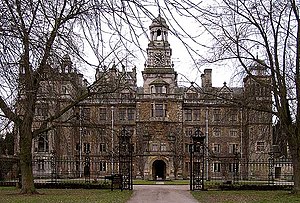The Dukeries

The Dukeries is an area in the north of Nottinghamshire, within the ancient Sherwood Forest, to the south of Worksop, which has been called the "Gateway to the Dukeries" (or in its own boasting the ‘Capital of the Dukeries’). This area received its flippant name because it contained four ducal seats.
The ducal seats were:
- Worksop Manor: a home of the Dukes of Norfolk, and nearest to Worksop;
- Welbeck Abbey: seat of the Dukes of Portland;
- Thoresby Hall: seat of the Dukes of Kingston (later of the Earls Manvers); and
- Clumber House: seat of the Dukes of Newcastle, since demolished, but whose parklnd is maintained by the National Trust.
In addition in the area:
- Rufford Abbey is a large country house which was the seat of the 2nd to 8th Savile baronets, their later-to-be ennobled heirs (with the territorial designation of Halifax), then from 1888 until 1938 to Baron Savile|1st to 3rd Lords Savile.
- Welbeck Woodhouse, in the former park (grounds) of Welbeck Abbey, was built by Lord Titchfield, later 7th Duke of Portland, in the 1930s.
Character
The Dukeries saw four ducal families in close proximity among fewer than twenty at any given time current (extant) English dukedoms and their parks or farmed lands largely neighbouring to the point of being at most points touching (contiguous).
The last mansion in single-family occupation is Welbeck Abbey – by a great-nephew of the final (seventh) Duke of Portland. The late Duke had neighbouring Welbeck Woodhouse built in the early 1930s when he bore his courtesy marquessate style. The latter property is equally intact, three-quarters of a mile north-east of the main house and 200 feet long.
The incumbent Duke of Norfolk sold Worksop Manor to the Duke of Newcastle in 1839. The Norfolks preferred to spend more time at Arundel Castle in Sussex and the Duke of Newcastle wanted the land to enlarge his estate and had the main part of the house demolished. The service wing was adapted into a smaller country house later in the 19th century, which survives.
Clumber House was demolished by the Dukes of Newcastle in the 1930s after a fire and the First World War because they could no longer afford the upkeep, but the Victorian chapel survived, and the 3,800-acre park now belongs to the National Trust.
Thoresby Hall opened as a country house hotel early in the 21st century after a period of neglect, though the wider Thoresby Estate remains in the hands of the descendants of the Dukes of Kingston.
Although not part of the Dukeries, Nottingham Castle, a former residence of the Dukes of Newcastle is also situated in Nottinghamshire, as is the former seat of the Dukes of St Albans at Bestwood Lodge. Bestwood St Albans, a parish in the west of Nottinghamshire, maintains a link with the Dukes of St Albans through its name.
Dukeries Coalfield
In the early 20th century the economic and social base of the Dukeries was dramatically influenced by the development of its underlying coalfield, the eastern extension of the Nottinghamshire coalfield.[1]
Five coal mines were opened after the first shaft sinking commenced in 1920. The coal mines were at Clipstone (coal won 1922), Ollerton (1925), Blidworth (1926), Bilsthorpe (1927) and Thoresby near Edwinstowe (1928).[2] The landowners auctioned or leased their mineral rights: Earl Manvers' Thoresby estate in May 1919 and Lord Savile of Rufford Abbey's lease for Ollerton in 1921.[3] Colliery companies such as the Butterley Company at Ollerton and the Stanton Company at Thoresby bought the rights.[4] The companies financed the construction of pit villages to house the miners and their families, who migrated from older coalfields throughout Britain.[5]
The villages offered facilities, such as a distinctive heating system provided by the mine running in pipes between houses in New Ollerton.[6] While displaying characteristics of paternalism the villages were restrictive, as some companies employed company policemen[7] and discouraged trade unionism, apart from the breakaway Nottinghamshire Miners' Industrial Union (NMIU) of George Spencer in the 1930s. Work at the Dukeries collieries did not cease even during the coal and general strike of 1926.[8] The Labour party was not electorally successful in the mining villages until 1946, after the Second World War had weakened the power of the employers.[9]
Outside links
References
- ↑ Waller, Robert (1983). The Dukeries Transformed. Oxford Historical Monograph. Oxford: Oxford University Press. ISBN 0-19-821896-6.
- ↑ Waller (1983), p. 5
- ↑ Waller (1983), p. 14
- ↑ Waller (1983), p. 15
- ↑ Waller (1983), pp. 25–53
- ↑ Waller (1983), p. 79
- ↑ Waller (1983), pp. 98–100
- ↑ Waller (1983), pp.108–130
- ↑ Waller (1983), pp. 131–162
| Noble seats of The Dukeries in Nottinghamshire |
|---|
|
Clumber Park • Rufford Abbey • Thoresby Hall • Welbeck Abbey • Worksop Manor • Welbeck Woodhouse |